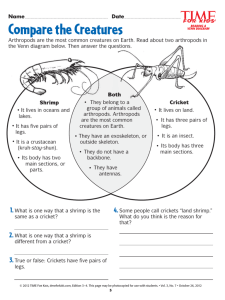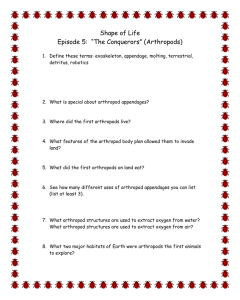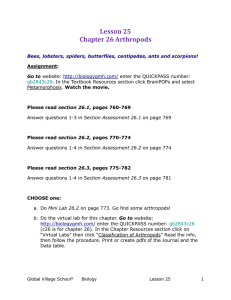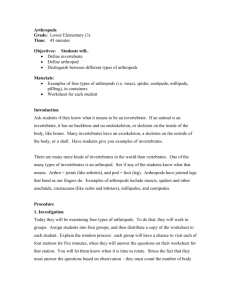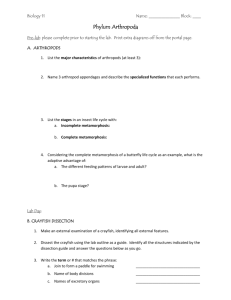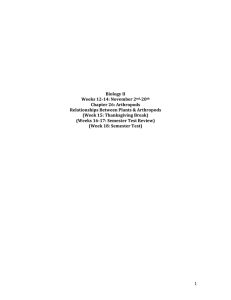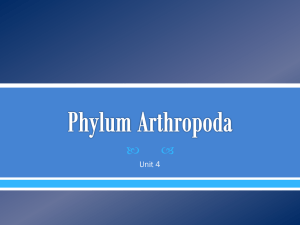Arthropod Characteristics
advertisement
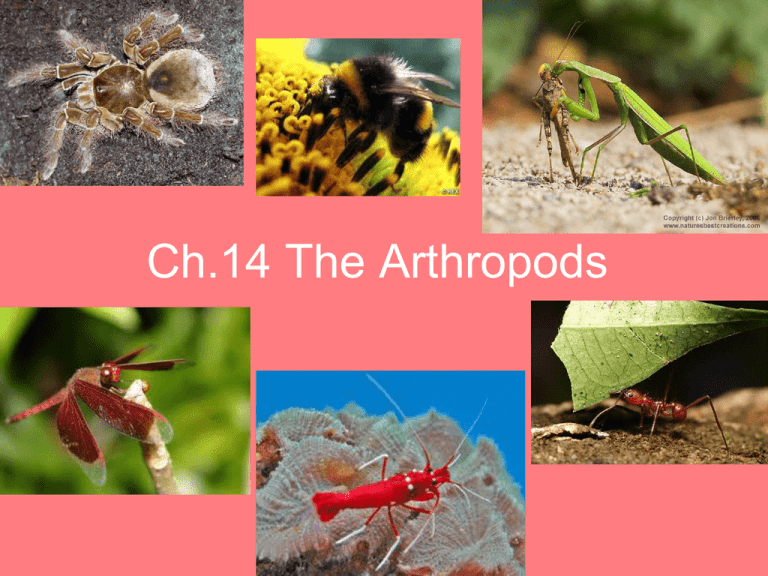
Ch.14 The Arthropods Arthropod Characteristics • 70-85% of all named animals species are arthropods! The majority of which are insects (beetles, flies, wasps, butterflies) • Segmented invertebrates • Bilateral Symmetry • Protostome development • 3 main body segments: – Thorax: middle body region – Abdomen: posterior end – Cephalothorax: head Arthropod Characteristics • • • • • • • Metamerism & Tagmatization Chitinous exoskeleton-provides support & protection Paired, jointed appendages Grow by molting (ecdysis) Ventral nervous system Small coelom Open circulatory system – Blood released into hemocoel (tissue space) • Complete digestive system • Metamorphosis usually present – Different body forms at different stages of development (reduces competition between immature and adult stages) Exoskeleton Provides structural support, protection, impermeable surfaces for the prevention of water loss, and a system of levers for muscle attachment and movement. • Two layers: – Epicuticle – outermost layer • Waxy lipoprotein • Impermeable to water • Barrier to microorganisms & many pesticides – Procuticle – inner layer, thickest • Made up of Chitin (tough substance-think leather) • Hardens by sclerotization (hardening & tanning process) Jointed Appendages • Appendages: structures, such as legs and antennae, that grow and extend from an animal’s body. • Arthropods have paired appendages. • Appendages of arthropods are adapted for a variety of functions such as feeding, mating, sensing, walking, and swimming. • Arthropod appendages are jointed-enable flexible movement. Feeding & Digestion • The mouthparts of most arthropods include a pair of appendages called mandibles that can be adapted for biting or chewing. • Other arthropods have mouthparts modified like feathery strainers, stabbing needles, cutting swords, or sucking straws. • Arthropods can be herbivores, carnivores, filter feeders, omnivores, or parasites. • Arthropods have a complete, one way digestive system with a mouth, gut, and an anus, along with various glands that produce digestive enzymes. Respiration 1. Gills – Most aquatic arthropods have gills that function in the same way as they do for mollusks 2. Tracheal tubes – Terrestrial arthropods, tubes branch into smaller and smaller tubules that carry oxygen throughout the body. 3. Book lungs – Saclike pockets with highly folded walls for respiration, folded walls increase surface area and allow for efficient exchange of gases. • Both tracheae and book lungs open to the outside of the body of the arthropod in openings called spiracles. Excretion • Cellular wastes are removed from the blood through Malpighian tubules. • Malpighian tubules are attached to and empty into the gut, which contains the undigested food wastes to be eliminated from the body. • Crustaceans and some other arthropods do not have Malpighian tubules, they have modified nephridia, similar to those in annelids. Response to Stimuli Vision: – Arthropods have large, compound eyes. – A compound eye has many facets, which are hexagonal in shape. – Each facet sees part of an image and the brain combines the images into a mosaic. – Compound eyes can detect the movements of prey, mates, or predators, and also can detect colors. – Many arthropods have 3-8 simple eyes as well as their compound eyes! (Only distinguishes light and dark) Response to Stimuli • Chemicals: – Pheromones: chemicals secreted by many animal species that influence the behavior of other animals of the same species. – Arthropods give off a variety of pheromones that signal behaviors such as mating or feeding. • Hearing: – In addition to eyes, many arthropods also have another sense organ called a tympanum-a flat membrane used for hearing. – It vibrates in response to sound waves. – Arthropod tympanums can be located on the forelegs as in crickets, or on the abdomen as in some grasshoppers, or on the thorax as in some moths! Reproduction • Most arthropods reproduce sexually and have a variety of adaptations for reproduction. • Most arthropods have separate sexes, but a few such as barnacles, are hermaphrodites and undergo crossfertilization. • Most crustaceans brood, or incubate, their eggs in some way, but they do not care for their hatched offspring. • Some spiders and insects also incubate their eggs, and some, such as bees, care for their young! Ecdysis (molting) • Four stages – 1. enzymes digest old procuticle – 2. new procuticle and epicuticle secreted – 3. old exoskeleton splits along predetermined lines when the animal stretches by air or water intake & then shedding occurs – 4. calcium carbonate deposits & sclerotization harden new exoskeleton Cicada Molting Metamorphism • Reduces competition between adults and immature stages • Is a radical change in body form and physiology as an immature stage, usually called a larva, becomes an adult. Taxonomy of Phylum Arthropoda: • Page 217, Table 14.1 Subphylum Trilobitomorpha • Extinct, lived in oceans 600 million years ago • Oval body & body could roll into a ball to protect its ventral surface! • 3 tagmata: – Head – Thorax – Pygidium Subphylum Chelicerata • Means “many claws” • Tagmata: – Prosoma (Cephalothorax) • Anterior • sensory & feeding – Opisthosoma • Posterior to prosoma • Contains organs for reproduction, digestion, respiration, and excretion – Paired appendages – for locomotion • Chelicerae – pincerlike, feeding • Pedipalps – sensory, feeding • Paired walking legs Class Merostomata 1. Giant water scorpion • Extinct • six-legged • about 5 feet long &3 feet wide 2. Horseshoe crabs – Only 4 species of horseshoe crabs live today, they were in existence 600mya – Can be found in the Gulf of Mexico! – 2 Chelicerae, 2 pedipalps, 6 chelate walking legs, 2 digging (or swimming) appendages – 5 pairs of book gills – Dioecious,external fertilization (congregate in intertidal areas to mate) – Oviparous – lays eggs – Eat small invertebrates Class Merostomata Class Arachnida • Order Scorpionida – Scorpions • Order Araneae – Spiders • Order Opiliones – Harvestmen (daddy longlegs) • Order Acarina – Ticks & mites • Mostly nocturnal • 2 small chelicerae near mouth, 2 large pedipalps with pincers, 8 walking legs • Most sting like a wasp, only a few have deadly venom • Dioecious, courtship can last hours, mating is internal • Most Ovoviviparous – internal but, large yolky eggs • Some Viviparous – mother provides nutrients for embryos • Development about 1.5 years for 20 to 40 young • After birth, young crawl onto mother’s back (one month) Scorpions Spiders • About 34,000 species (largest arachnid group) • 2 poisonous chelicerae with fangs, 2 pedipalps for sperm transfer, 8 walking legs • 6 to 8 eyes • 6 to 8 spinnerets eject silk • Silk protein comes out as a liquid, then hardens • Ballooning – using silk line to travel hundreds of kilometers • Bite prey, paralyze them, wrap them in silk, inject enzymes, & suck victim dry • Females attract males to web with pheromones • Internal fertilization & oviparous (egg outside body) Black Widow Lactrodectus mactans *Recognized by its shiny black body with a red hourglass pattern on its ventral surface *Neurotoxin: “nerve poison” can cause paralyses, difficulty of breathing, vomiting, fever, & sweating Brown Recluse Loxosceles reclusa •Hemotoxin: destroys red blood cells, disrupts blood clotting, and causes tissue damage. •Recognized by the dark brown, violinshaped mark on the dorsal surface. Daddy Longlegs or Harvestmen • Long legs • Most are omnivores, some predators • Not harmful to humans Mites & Ticks • Mites 1mm or less – Free-living are herbivores & scavengers – Ectoparasites, most stay attached a few hours or days – Chigger (redbug) larvae burrow in skin, drop off to molt – Harmless follicle mite is permanent-most of us actually have this mite! – Itch mite causes Scabies (skin disease that causes extreme itching) • Ticks up to 3cm – Ectoparasites all throughout their life – Copulation on host, females drop to ground to lay eggs Chigger Scabies Tick Class Pycnogonida • Sea spiders • All Marine and most common in cold water • Predators • Dioecious and males carry eggs until they hatch! Subphylum Crustacea • Class Malacostraca – Crabs, lobsters, crayfish, shrimp, krill, isopods, amphipods • Class Branchiopoda – Fairy shrimp, brine shrimp, water fleas • Class Maxillopoda – Copepods, barnacles Class Malacostraca Greek “malakos”=soft + “ostreion”=shell • • • • • • • Crabs, lobsters, crayfish, shrimp, krill, isopods, amphipods Omnivores & scavengers Have gills Hemocoel present Compound eyes on movable eye stalks Dioecious (except for barnacle) Abdomen is reduced and is held beneath the Cephalothorax – Head & Thorax (using crayfish as example) • 2 pairs of antennae, grinding mandibles, 2 pair maxillae, 3 pairs of maxillipeds, 5 pairs of walking legs (1st is large and chelate), males have an extra 2 pairs of claspers), 5 pairs of swimmerets, telson with uropods (flipperlike) Reproduction • Dioecious • Males flip females over and deposit sperm • “Sticky” eggs develop on tale of female • Larval stages can lasts months Class Branchiopoda • Fairy shrimp & brine shrimp – Mostly freshwater – During droughts, embryos become dormant in capsules • Water fleas (Daphnia!) – Look like fleas with large carapace – In spring, females reproduce parthenogenetically (without fertilization) – In winter, sexual reproduction produces winter eggs that hatch in spring Class Maxillopoda • Copepods – Some or the most abundant crustaceans – Marine and freshwater – Few live on substrate and filter feed, some are predatory, others are parasites • Barnacles – Sessile adults – Marine only and ~1,00 species – Filter-feeders – Mostly monoecious – Many will colonize ships and boats, rocks, and even other animals, like whales! Subphylum Myriapoda • 4 Classes: – Diplopoda (millipedes) – Chilopoda (centipedes) – Symphyla (symphylans) – Pauropoda (pauropodans) Class Diplopoda Millipedes • Have 11-100 trunk segments • 2 pairs of appendages on each trunk segment • Worldwide in distribution and are found in or under leaf litter or decaying logs • Feed on decaying plant matter • Millipedes roll into ball when disturbed Class Chilopoda Centipedes • Mostly nocturnal • Scurry about the surfaces of logs, rocks, or other forest-floor debris • Single pair of long legs on each segment • 15 or more trunk segments • Fast-moving predators • Food is small arthropods, earthworms, and snails and sometimes even frogs and rodents • Poison claws kill or immobilize prey…most venom is harmless to humans, although many have bites comparable to a wasp and a few human deaths have been reported from large, tropical species • Legs and segments are added with each molt

